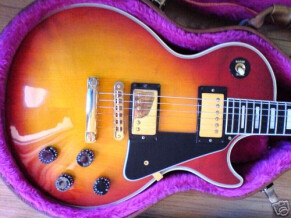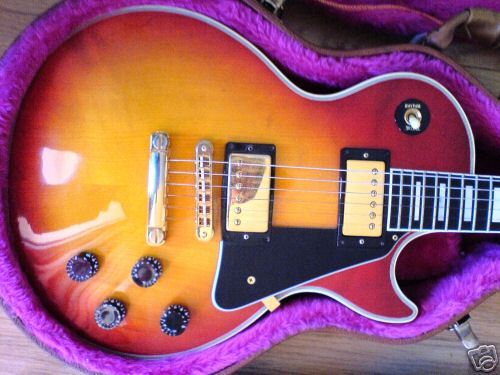Insatisfait(e) des avis ci-contre ?
Filtres
Nos membres ont également aimé :
3.0/5(2 avis)
100 %
Donner un avis
Avis des utilisateurs
 Hatsubai
HatsubaiVersion ère Norlin
Publié le 25/10/11 à 00:04 (contenu en anglais)During the Norlin era, they made some of my favorite Les Pauls. However, they also made some of the worst ones as well. This particular guitar actually has what is known as the "pancake" body, and it's a huge step back in tone, in my opinion. The guitar features a mahogany body with a maple top, a mahogany neck with an ebony fretboard, 22 frets, trapezoid inlays, binding, a TOM style bridge, two humbuckers, two volumes, two tones and a three way switch.
(contenu en anglais)During the Norlin era, they made some of my favorite Les Pauls. However, they also made some of the worst ones as well. This particular guitar actually has what is known as the "pancake" body, and it's a huge step back in tone, in my opinion. The guitar features a mahogany body with a maple top, a mahogany neck with an ebony fretboard, 22 frets, trapezoid inlays, binding, a TOM style bridge, two humbuckers, two volumes, two tones and a three way switch.
UTILIZATION
This guitar was heavy; pig heavy. It had like 11 pieces of wood all glued together or something. I couldn't believe how many pieces of wood they threw on this guitar. It was, no joke, in the 12+ lb range, and it just killed my back to play this thing. That's the biggest issue with these pancake body guitars. There are some good ones out there that, despite looking kind of ugly, have a great tone. However, there are ones like these that just can't sound good no matter what you do. It's like a boat anchor. The fretwork on this was average, and considering it wasn't played much, there wasn't a ton of fretwear. The nut needed to be recut, but that's a pretty minor issue considering the rest of the guitar.
SOUNDS
The guitar didn't resonate like a normal Les Paul normally does. For those that don't know, a heavier guitar is not necessarily a better guitar. I find that the lighter ones tend to be a bit more resonant, and it's the lighter ones that tend to be the best in terms of overall tone. These super heavy ones seem to have a very dull tone that doesn't sparkle like the lighter ones do. This particular guitar had the Gibson Dirty Fingers in the bridge but the stock pickup in the neck. The Dirty Fingers is ridiculously high output, and it has tons of sustain, but it seemed to be hampered in this guitar. The neck pickup was too bright for me, and I found myself turning down the tone knob when I was playing leads or cleans.
OVERALL OPINION
Some of these guitars are awesome, but this is an example of one of the bad ones that left the factory around this time. This is also an example as to why people tend to not like the Norlin era guitars. They were very inconsistent, but considering how inconsistent Gibson is today, I guess it's not as much of a shock anymore... If you buy used, be sure to be ready to flip it for that "just in case" moment.00 Hatsubai
HatsubaiVersion ère Norlin
Publié le 25/10/11 à 00:05 (contenu en anglais)During the Norlin era, they made some of my favorite Les Pauls. However, they also made some of the worst ones as well. This particular guitar actually has what is known as the "pancake" body, and it's a huge step back in tone, in my opinion. The guitar features a mahogany body with a maple top, a mahogany neck with an ebony fretboard, 22 frets, trapezoid inlays, binding, a TOM style bridge, two humbuckers, two volumes, two tones and a three way switch.
(contenu en anglais)During the Norlin era, they made some of my favorite Les Pauls. However, they also made some of the worst ones as well. This particular guitar actually has what is known as the "pancake" body, and it's a huge step back in tone, in my opinion. The guitar features a mahogany body with a maple top, a mahogany neck with an ebony fretboard, 22 frets, trapezoid inlays, binding, a TOM style bridge, two humbuckers, two volumes, two tones and a three way switch.
UTILIZATION
This guitar was heavy; pig heavy. It had like 11 pieces of wood all glued together or something. I couldn't believe how many pieces of wood they threw on this guitar. It was, no joke, in the 12+ lb range, and it just killed my back to play this thing. That's the biggest issue with these pancake body guitars. There are some good ones out there that, despite looking kind of ugly, have a great tone. However, there are ones like these that just can't sound good no matter what you do. It's like a boat anchor. The fretwork on this was average, and considering it wasn't played much, there wasn't a ton of fretwear. The nut needed to be recut, but that's a pretty minor issue considering the rest of the guitar.
SOUNDS
The guitar didn't resonate like a normal Les Paul normally does. For those that don't know, a heavier guitar is not necessarily a better guitar. I find that the lighter ones tend to be a bit more resonant, and it's the lighter ones that tend to be the best in terms of overall tone. These super heavy ones seem to have a very dull tone that doesn't sparkle like the lighter ones do. This particular guitar had the Gibson Dirty Fingers in the bridge but the stock pickup in the neck. The Dirty Fingers is ridiculously high output, and it has tons of sustain, but it seemed to be hampered in this guitar. The neck pickup was too bright for me, and I found myself turning down the tone knob when I was playing leads or cleans.
OVERALL OPINION
Some of these guitars are awesome, but this is an example of one of the bad ones that left the factory around this time. This is also an example as to why people tend to not like the Norlin era guitars. They were very inconsistent, but considering how inconsistent Gibson is today, I guess it's not as much of a shock anymore... If you buy used, be sure to be ready to flip it for that "just in case" moment.00








